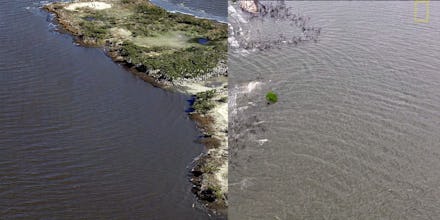Watch How the BP Oil Spill Destroyed This Entire Island in One GIF

The 2010 BP Deepwater Horizon oil spill in the Gulf of Mexico was an environmental catastrophe. Over 87 painful days, the largest oil spill in U.S. history left 200 million gallons of crude washing around the Gulf. Now, National Geographic has released a new video that shows how the damage was worse than previously imagined.
The cost was not tallied merely in effects on birds and marine life, but in literally causing an entire island off the coast of Louisiana to almost completely vanish.
This alarming GIF provides a snapshot of the destruction suffered by Cat Island.
Cat Island wasn't the most famous place in the world, but its importance to the local ecosystem cannot be overstated. It was one of the largest nesting grounds for local birds, including some varieties that are rare and endangered, National Geographic reports in the video. Brown pelicans, snowy egrets and several species of heron were among those known to frequent the area.
The island had been mostly held together by a system of mangrove roots. In 2010, oil bubbling up from the site of the spill began to degrade that ecosystem, which literally caused the island to dissolve. The loss reverberated far beyond the actual land. According to U.S. government studies cited by the report, nesting birds continue to flock to area, but with the island disintegrating, they do not breed.
"We're losing generation after generation of birds," P. J. Hahn, a former Louisiana coastal official, told National Geographic.
While the oil spill that destroyed Cat Island may appear to be a one-off, it is in fact plainly symptomatic of the world's struggle against climate change. Around the world, larger islands and even densely populated island nations are under threat. The pacific island nation of Kiribati, with a population of over 100,000, might also be on its way to sinking into the waves. Rising seas, meanwhile, have made more and more land in low-altitude nations, like Bangladesh, uninhabitable, and increase the risk of deadly flooding.
The insatiable drive for ever-more-remote deposits of yesterday's energy is not the road the world should be taking. If the Exxon-Valdez crash, America's last great oil spill, offers any lesson, it's that recovery for the Gulf will be measured not in years but in decades. While cost-benefit schemes for new energy sources, like solar and wind, are still being worked out, at least these new technologies aren't causing islands to sink or destroying precious ecosystems.
Speaking to National Geographic, officials promised to restore Cat Island to its original state. While that's a laudable goal, it's even more critical to prevent other places from suffering the same fate.
h/t IFLScience